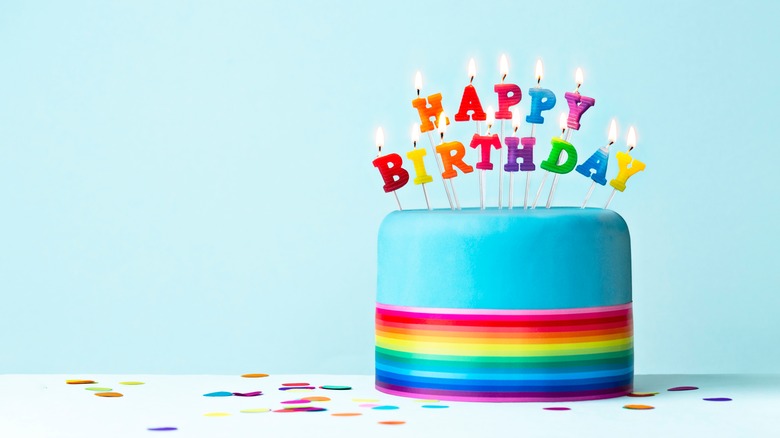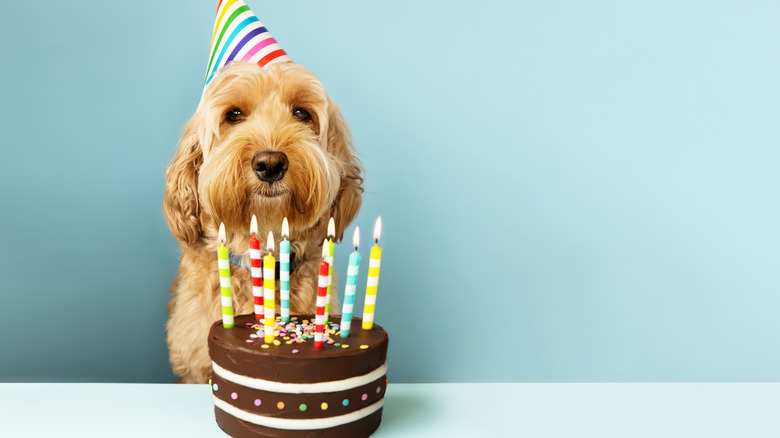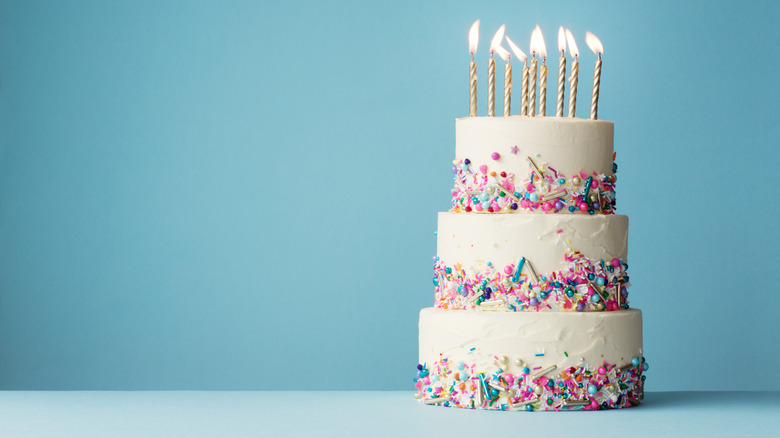Birthday Cake Candles Used To Signify Something Way Different
Not only are birthday cakes delicious, but when you see one, it can help you recall fond childhood birthday memories. Whether you were wearing a multicolored birthday hat, a princess crown, or a Batman mask, you may have eagerly anticipated family and friends gathering around a table to sing "Happy Birthday," concluding with the classic countdown.
Similarly, you may have looked forward to seeing a new candle appear on your cake when you were younger. Celebrants may have started removing candles at a certain point in your life. Or maybe, they lit up the entire cake because you should be celebrating each new year of your life. Some joke that being one year older is better than the alternative. Regardless of your birthday celebrations, you probably associate the number of birthday candles on a cake with your age — maybe an extra candle for good luck — and believe blowing out the candles represents making a wish. But at one point, birthday cake candles used to have an entirely different meaning.
Birthday cake candles and the heavens
Thanks to the Germans, there are some superstitions surrounding birthday candles that you may not be familiar with. In the academic article "Birthday Cakes: History and Recipes," readers learn that lighting candles on a birthday cake is a tradition that probably started in the 18th century in Germany. People got together to help celebrate a German count's birthday. One of the participants described the event, which says, "... there was a cake as large as any oven could be found to bake it, and holes made in the cake according to the years of the person's age, every one having a candle stuck into it, and one in the middle." Today, the common catchphrase in the U.S. is "And one for good luck." But what did the extra candle mean to Germans at the time?
According to FOODBEAST, the candle in the middle of the cake, or an extra candle, was meant to signify "the light of life." In other words, it indicated great wishes that the person celebrating their birthday would live another year. The candles being lit stood for the light coming from the moon. After the candles were blown out, the smoke that followed represented messages sent into the heavens so that God could receive them.
The surprising link between birthday candles and evil
While some birthday traditions may seem similar to those you've heard of today, others likely don't come to mind immediately. For example, in Germany, the smoke from the candles was supposed to get rid of any evil spirits that may be present in the participants' lives. People believed that evil spirits often came to them on their birthdays. Along with using smoke from the candles as a protective measure to get rid of them, people also joined together, and as Jennifer Lopez invites you to do, they got loud. Ideally, they hoped the noise would scare off these evil spirits. Some sources suggest that is how birthday parties first began.
While we may have evil spirits to thank for birthday parties, it is not evident how the birthday cake tradition eventually spread from Germany to the rest of Europe. And before the mid-nineteenth century, celebrating birthdays in the U.S. was not a common practice like it is now. Birthday cake candles in the U.S. were rarely mentioned until 1871. In an article from the "Ladies Repository," the writer states, "The huge, decorated birthday cake is placed in the center-table, and around it are ranged lighted candles, graduate in length and number by the age of the child." References to kids blowing out the candles on a cake first appeared in the late-nineteenth century in Switzerland. In the U.S., any other mention of candles on a cake did not appear until 1909 in a kids' magazine. Although the U.S. may have been a little later to the birthday party, whether you're American or from any other part of the world and superstitious, you can use your next birthday as an excuse to conquer evil.


